by Maxine Carter-Lome, publisher
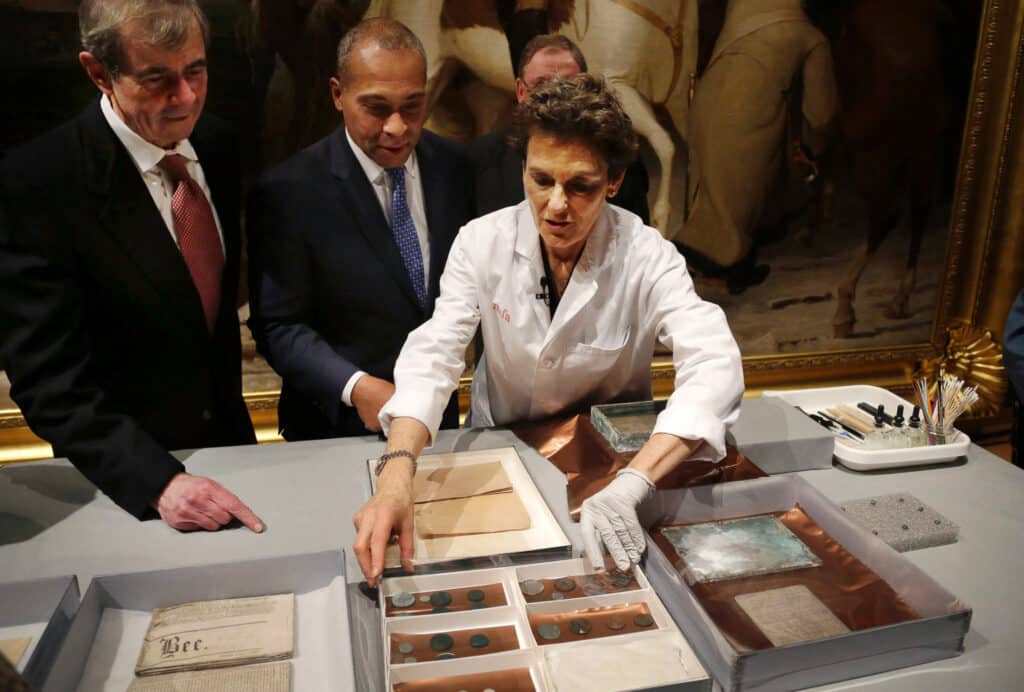
A time capsule is a historic cache of goods or information, usually intended as a deliberate method of communication with future people, and to help future archaeologists, anthropologists, or historians.
Time capsules have been used for thousands of years to preserve a piece of the present for the future but became a craze during the Victorian Era. According to The Edges of Time: Cornerstones & Time Capsules of Early Victoria, “The creation of a time capsule is an example of how people of the Victorian era commemorated time … Time capsules can be found in many cornerstones of buildings built in the Victorian era in Victoria, British Columbia. The content of each time capsule varies; however, the ‘usual deposits’ include coins, newspapers, and religious or historical statements. These objects show us the importance of religion and prosperity during the era. They also give us a glimpse into the Victorian understanding of time. These time capsules had no intended retrieval date and were expected to endure until the apocalypse.”
Here in America, burying boxes containing messages for future generations dates to the late 18th century and founding patriots Paul Revere and Samuel Adams; however, the term “time capsule” was not popularized until the 1939 New York World’s Fair with the burial of a torpedo-shaped cylinder, initially called a “time bomb,” filled with artifacts of significance at the time.
Here is a peek inside some of the most important historical time capsules unearthed to date.
Oldest U.S. Time Capsule: Paul Revere and Samuel Adams
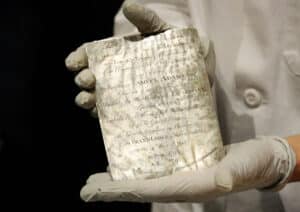
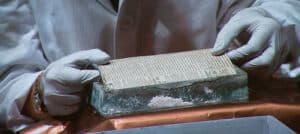
America’s oldest known time capsule was made by Paul Revere and Samuel Adams and uncovered in 2014 by repairmen fixing a water leak at the Massachusetts State House. The two former Sons of Liberty placed a brass box in a cornerstone to mark the building’s construction back in 1795. It had already been opened once in 1855 for cleaning, and the addition of new artifacts, and historians were initially unsure if its contents had survived intact. When it was finally unsealed in 2015, however, it was found to contain a trove of preserved artifacts, including newspapers, coins dating back to the 1600s, a page from the Massachusetts Colony Records, and a copper medal with an image of “General of the American Army” George Washington. Most exciting of all was a silver plaque—most likely the work of Revere—that read, “This cornerstone of a building intended for the use of the legislative and executive branches of the government of the Commonwealth of Massachusetts was laid by His Excellency Samuel Adams, Esquire, governor of the said Commonwealth.”
The value of the contents is unknown, but collectors would pay a “premium” for items from the oldest time capsule in the country, Heritage Auction’s co-founder and co-chair Jim Halperin told ABC News back in 2015. When its contents were documented and cleaned, officials said, additional materials were added to the time capsule, which was placed in brass and plastered into the underside of the granite cornerstone.
Time Capsule Under Robert E. Lee Statue
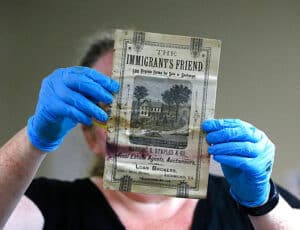
There were coins, some of them stuck to paper, and several denominations of paper money, as well as five or six Minié balls, which are rifle bullets that were used in the 19th century. There was also an 1884 commemorative ribbon used as a bookmark that featured a drawing of Robert E. Lee.
An April 29, 1865, issue of Harper’s Weekly featured a printed image appearing to show a person grieving over the casket of President Abraham Lincoln. There was speculation that the box may have contained a rare photograph of Lincoln in his coffin, though they did not find it upon their initial unpacking.
The Century Safe
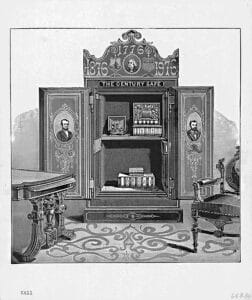
“Century Safe” placed beneath the U.S. Capitol in 1879.
In 1876, the Century Safe, exhibited at the 1876 Philadelphia World’s Fair, was stored at the US Capitol, designated for opening at the nation’s bicentennial in 1976. A woman named Anna Diehm, publisher of the Our Second Century weekly, had the idea and assembled the contents in a fireproof cabinet. President Ulysses S. Grant observed the ceremonial closing.
According to oldest.org, after its sealing in 1879, the Century Safe was placed under the East Portico of the U.S. Capitol building, where it remained forgotten. It was not until the bicentennial celebrations in July 1976 that the time capsule was rediscovered, restored, and opened as scheduled.
Its opening was witnessed by President Gerald Ford and Congressional leaders. Inside was a book on Temperance, a scroll signed by members of the 44th Congress, an album with autographs of other prominent men, a gold pen from poet Henry Wadsworth Longfellow, and photos by photographer Matthew Brady. It is said that Diehm’s concept of a “preservation safe” led the way for future vaults and a time capsule craze that swept the nation.
The Westinghouse Time Capsule
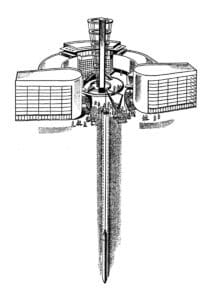
During the future-themed 1939 New York World’s Fair, the Westinghouse Electric and Manufacturing Company entombed a torpedo-shaped cylinder inside a 50-foot-deep “Immortal Well” on the fairgrounds in Flushing Meadows. The cylinder was originally called a “time bomb,” but the name was changed after a Westinghouse publicist coined the now-famous term “time capsule.”
Another capsule was placed nearby in 1965, and both are now scheduled for opening in the year 6939 A.D. – 5,000 years after the first one was buried. The items inside the two capsules include a collection of seeds, metals, textiles; microfilm and newsreels; and everyday items such as a Beatles record, a bikini, a pack of Camel cigarettes, and a plastic child’s cup featuring Mickey Mouse. The 1939 capsule also featured a letter from physicist Albert Einstein, who praised the scientific progress of his age but also added that “People living in different countries kill each other at irregular time intervals, so that also, for this reason, anyone who thinks about the future must live in fear and terror.”
Detroit’s Century Box
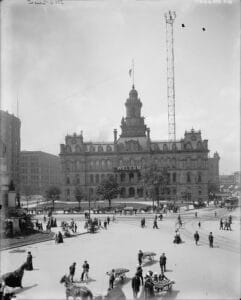
It was demolished in 1961.
Shortly after the clocks struck midnight on January 1, 1901, Mayor William C. Maybury sealed a copper time capsule at Detroit’s Old City Hall and proclaimed that it was not to be touched for 100 years. When Detroit Mayor Dennis Archer finally opened the “Century Box” in December 2000, it was found to contain several dozen letters to the future written by the city’s business and political leaders. Most of the missives included descriptions of the wonders of 1900 Detroit along with musings on what life in the 21st century might be like. “How much faster are you traveling?” Maybury asked his future successor. “We talk by long-distance telephone to the remotest cities in our own country … Are you talking with foreign lands and to the islands of the sea by the same method?” Other prognosticators were not so accurate. A few speculated that Canada would be annexed or that Ontario would become a U.S. state, and the Metropolitan Police Commissioners wrote that, “prisoners instead of being conveyed to the several police stations in Automobile patrol wagons will be sent through pneumatic tubes, flying machines, or some similar process.”
Time Capsules in Outer Space
Currently, there are two time capsules in space. They are primarily intended for potential extraterrestrial life or future space explorers. Their purpose extends beyond the earthly audience, aiming to represent the entirety of humanity and Earth to other intelligent life forms or future human generations that may travel far into space.
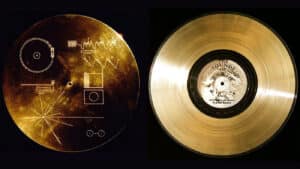
details about Earth’s location in space.
Voyager Golden Record I and II were attached to two Voyager spacecraft and launched in 1977. This time capsule (I and II are identical) is a gramophone record meant to portray culture on Earth to any intelligent extraterrestrial life. Music, natural sounds, images from around the world, and greetings in 55 languages are included on the record. This is an example of a time capsule with an unknown opening date.
Make Your Own Time Capsule
The Library of Congress offers the following advice to those interested in making a time capsule.
Choose a good storage container – Storage considerations for a good time capsule are not very different from those for good storage in
general. The main point of distinction is that general storage takes into consideration regular or occasional access to the contents, whereas a time capsule is intended to stay closed and undisturbed until it is opened after a certain period of time. The objective in both situations, however, is the same: that the contents remain in as good a state of preservation as possible. Choose a tightly closed container made of
chemically inserted materials that will keep out light, dust, and other air-borne pollutants, and water.
Choose a good location for the container – A cool (room temperature or below), relatively dry (about 35% relative humidity), clean, and stable environment (avoid attics, basements, and other locations with high risk of leaks and environmental extremes) with minimal exposure to all kinds of light; no exposure to direct or intense light, is best.
Consider your content:
• Analog items are not machine-dependent, but digital items are, including the machine required for digital items and instructions for use.
• Materials that have already withstood the test of time have proven to be long-lasting; the long-term behavior of new materials is more unknown.
• Safer, more traditional choices include items printed or written with carbon-based ink on acid- and lignin-free, good quality paper; well-processed black-and-white photographs; non-corroding metals; textiles made of non-plastic fibers; glass; stone; ceramic; items made of uncoated PET, HDPE, or PP plastics.
• Further minimize the risk of unexpected chemical interactions among the time capsule contents by packaging each item: put each item or group of like items in acid- and lignin-free paper envelopes, folders, or boxes; uncoated PET zipper bags; or glass or PET, HDPE, or PP plastic vials with screw-top lids.
• Avoid including food items and plants or other living things.
• Include a list of the contents in the time capsule and why they were included.
• Minimize the risk of mechanical damage: put the heaviest items at the bottom; prevent items from rattling around; ensure the weight of the
contents within the time capsule container is evenly distributed; indicate on the outside of the container which side is up.





Related posts: